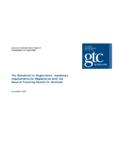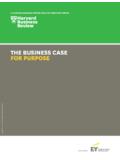Transcription of A practitioners’ guide to the new AICPA Code of ...
1 The Journal of Finance and Accountancy Volume 20 A practitioner s guide , Page 1 A practitioners guide to the new AICPA Code of Professional Conduct Todd A. Shawver Bloomsburg University of Pennsylvania Abstract In June 2014, the American Institute of Certified Public Accountants ( AICPA ) Professional Ethics Division adopted a revised version of the AICPA Code of Professional Conduct ( AICPA , 2014), that all public firms, businesses, and other members of the AICPA must adopt by December 15th, 2014. With that, there has been much discussion over the validity and application of the new standards. In the following, there will be a brief discussion of the conceptual framework of the new standards, an explanation of the new drafting guidelines, and multiple examples on how to apply the new standards using the new codification. Keywords: Ethics, AICPA , Professional Conduct, User, Copyright statement: Authors retain the copyright to the manuscripts published in AABRI journals.
2 Please see the AABRI Copyright Policy at The Journal of Finance and Accountancy Volume 20 A practitioner s guide , Page 2 INTRODUCTION The revised AICPA Code of Professional Conduct The new AICPA has restructured and now codified the Code of Professional Conduct. According to the AICPA , the reason for the restructuring and codification of the Code was so that members and other users of the AICPA Code can apply the rules and reach correct conclusions more easily and intuitively . The structure of the new Code is divided into separate parts: a preface that is applicable to all members, including structure, principles, definitions, non-authoritative guidance, and new, revised and pending interpretations of the new code; part one, which are standards applicable to public practice members; part two, which are standards applicable to business members; and Part 3, which are standards applicable to all other members of the AICPA .
3 The new Code is codified, which means that it is an easy-to-search database of the Professional Code of Conduct. The codification for the Code of Conduct has a numbering convention that appears as, for example, This numbering convention starts with a single digit, which correlates with the aforementioned parts: 0 Preface, 1 Public Practice Members, 2 Business Members, 3 Other Members. The second set of digits is the major section, for instance 400 refers to the section entitled Acts Discreditable . The third set of digits is the topic, for instance, 010 refers to the topic entitled Discrimination and Harassment in Employment Practices . The last digit is the paragraph pertaining to the section and topic, for instance 01 explains the discreditable act of violating federal, state and municipal antidiscrimination laws. There are other substantive changes to the code as well. The AICPA expanded the prior definition of self-review threat to describe that this self-review threat is also present for judgments made or work performed by an individual currently with the firm who was previously associated with the client.
4 It is noted within the code that there are no safeguards in place that could eliminate the potential of this self-review threat. There are also additional discussions of ethical conflicts, definition of attest clients and the term director , tax power of attorney and prospective clients confidential information, false misleading or deceptive acts, billing for subcontractor services, attest engagement performed with former partner, use of AICPA awarded designation, loans and lending institutions, and blind trusts. PRINCIPLES OF THE AICPA CODE OF PROFESSIONAL CONDUCT The principles outlined within the new code are similar to that of the extant code. The principles are: Responsibilities Principle, The Public Interest Principle, The Integrity Principle, Objectivity and Independence Principle, Due Care Principle, and the Scope and Nature of Services Principle. Responsibilities Principle This principle states that members, in carrying out their responsibilities, should exercise sensitive professional and moral judgments in all of their activities.
5 Members of the AICPA must act in a manner that maintains public confidence in the accounting industry, and continually The Journal of Finance and Accountancy Volume 20 A practitioner s guide , Page 3 strive to improve the art of accounting, and understand the industries responsibilities of self-governance. Members should keep in mind that their actions affect many within and outside of the accounting industry. Public Interest Principle This principle states that members should proceed with their responsibilities, and keep the public interest in mind in their decisions, and honor the public trust and demonstrate a commitment to professionalism . The public consists of clients, credit grantors, governments, employers, investors, the business and financial community, and others who rely on the objectivity and integrity of members to maintain the orderly functioning of commerce . This principle also discusses the pressures that may come from the public, and the fact that members must maintain integrity, objectivity, due professional care, and a genuine interest in serving the public.
6 Integrity Principle To have integrity, a member must be honest and candid with constraints of client confidentiality . When a decision is made, it must be determined that the act is right or just. In the absence of specific rules, standards, or guidance, or in the face of conflicting opinions, a member needs to make sure that they make sure that their integrity is maintained through the decision. Objectivity and Independence Principle A member should maintain objectivity and independence and prevent any conflicts of interest in their practice. To be objective is to be impartial in the professional services offered by the member, and use professional judgement during the engagement with the client. To be independent is to preclude relationships that may hinder the objectivity of the member in the professional services being offered. Due Care Principle The due care principle suggests that a member observe the professions ethical and technical standards, continuously improve competence and quality of services, and, to the best of the member's ability, act in a professionally responsible manner.
7 Exercising due care is keeping the best interest of the client in mind as services are performed with diligence and competence. Scope and Nature of Services Principle The Code of Professional Conduct should be at the forefront of determining the scope and nature of services. If there is a probability that any of the aforementioned principles will be violated in providing professional services to the client, then it is assumed that violations of the code will exist. The Journal of Finance and Accountancy Volume 20 A practitioner s guide , Page 4 DECISION MAKING USING THE NEW CODE As with the extant code, there are many instances where the new AICPA Code of Professional Conduct will need to be referenced ( ). There are steps that should be followed using the Conceptual Framework, which are included in Exhibit 1. [INSERT FIGURE 1 HERE] Step 1: Identify Threats Take the scenario that has come up, and understand if there are any threats involved with the scenario.
8 If there are no threats, proceed with the scenario. If there are threats, then proceed to step two of the conceptual framework. Step 2: Evaluate Threats Evaluate the threats of the scenario, and determine whether or not the threats are at an acceptable level. If the threats are at an acceptable level, proceed with the scenario, otherwise, proceed to step three of the conceptual framework. Step 3: Identify Safeguards Identify the safeguards are in place to protect against any ethical conflicts. These safeguards refer to the internal controls the organization has in place to prevent unethical behaviors. These safeguards can be existing controls, or they may be new safeguards that are required to be developed with new circumstances. Step 4: Evaluate Safeguards The safeguards must be evaluated to determine if they eliminate or reduce threats to an acceptable level. Should the safeguards not eliminate or reduce the threats to an acceptable level, then the action should not be taken.
9 If the safeguards do eliminate or reduce the threats to an acceptable level, then the action should be taken. In the following, some examples will be provided, followed by instructions on how to attain information related to the situation in the new code. The link for the AICPA Code of Professional Conduct codification is: Please follow along with the examples to get hands-on experience in browsing the code. Example #1: Third-party service providers Mark Sands, CPA, a member of the AICPA , is contracted with a client to provide professional services. Due to workload restrictions, Sands decides to hire Alex Law, CPA, a third-party service provider, to assist in providing the professional services for this client. The member is concerned that this situation may be a violation of the AICPA Code of Professional Conduct. The Journal of Finance and Accountancy Volume 20 A practitioner s guide , Page 5 Resolution: Using Figure 1, Step 1, Mark must first identify threats.
10 The threat is that the third-party service provider would now have access to confidential client information. Step 2, Mark must evaluate the threats involved in this decision to seek third-party assistance with the client. Using a third-party service provider may contain threats to the Integrity and Objectivity Principle. Meaning that the third-party provider taking the confidential client information and disclosing it to other parties. In Step 3, Mark must also identify safeguards. Such arrangements should be disclosed to the client prior to the third-party arrangement commencing if confidential client information will be shared to the third-party. However, a member is not required to inform the client if the third party arrangement provides administrative support to the member where no confidential client information is shared. The member may also want to consult other sections of the Code as well to attain additional interpretations of third-party arrangements.

















